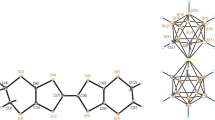Abstract
Two paramagnetic (1, 2) chromium metallomesogens were studied by the EPR, magnetic-susceptibility, and dielectric-spectroscopy methods. These mesogens possess columnar liquid-crystal phase polymorphism. For mesogen 1 in the columnar Colxd phase, an irreversible structural phase transition was detected by the EPR method. An anomalous nonlinear temperature dependence of the resonance fields of the EPR line positions and of the fine-structure parameter D in the mesophases of compound 1 was observed. It was shown that this anomaly is associated with the soft mode of crystal lattice. The dielectric spectroscopy data provide support for the existence of the soft mode, which is probably due to the transition of the system from a paraelectric to a dipole-ordered state. The structure of the hexagonal columnar plastic phase of mesogen 2 is formed by a single type of paramagnetic monomer chromium center and does not exhibit any specific features.
Similar content being viewed by others
References
A. M. Giroud-Godquin and P. M. Maitlis, Angew. Chem. Int. Ed. Eng. 30, 375 (1991).
S. A. Hudson and P. M. Maitlis, Chem. Rev. 93(3), 861 (1993).
Metallomesogens: Synthesis, Properties and Applications, Ed. by J. L. Serrano (VCH, Weinheim, 1996).
Y. Galyametdinov, G. Ivanova, I. Ovchinnikov, et al., Liq. Cryst. 20(6), 831 (1996).
L. M. Blinov, Liq. Cryst. 24(2), 143 (1998).
I. G. Bikchantaev and I. V. Ovchinnikov, Fiz. Tverd. Tela (Leningrad) 18(5), 1479 (1976) [Sov. Phys. Solid State 18, 861 (1976)].
N. M. Zhidomirov, Ya. S. Lebedev, S. N. Dobryakov, M. Ya. Shteinshneider, A. K. Chirkov, and V. A. Gubanov, Interpretation of Complex Spectra of Electron Spin Resonance (Nauka, Moscow, 1975).
B. R. McGarvey, J. Chem. Phys. 41(12), 3743 (1964).
A. Facher, Dissertation (Universität Bayreuth, 2000).
D. L. Huber and M. S. Seehra, Phys. Status Solidi B 74(1), 145 (1976).
Y. Yokozawa, J. Phys. Soc. Jpn. 31(5), 1590 (1971).
K. Tzuchida and R. Abe, J. Phys. Soc. Jpn. 46(4), 1225 (1979).
D. Barb, N. M. Grecu, V. V. Grecu, and F. F. Popescu, Chem. Phys. Lett. 56(2), 355 (1978).
G. V. Mamin and V. N. Efimov, Ferroelectrics 233(1–2), 111 (1999).
G. Burns, J. Appl. Phys. 32(9), 2048 (1961).
Author information
Authors and Affiliations
Additional information
__________
Translated from Fizika Tverdogo Tela, Vol. 43, No. 6, 2001, pp. 1145–1151.
Original Russian Text Copyright © 2001 by Domracheva, Ovchinnikov, Turanov, Lattermann, Facher.
Rights and permissions
About this article
Cite this article
Domracheva, N.E., Ovchinnikov, I.V., Turanov, A. et al. Features of the magnetic and dielectric behavior of mesophases of chromium (III) complexes with azacyclic ligands. Phys. Solid State 43, 1188–1194 (2001). https://doi.org/10.1134/1.1378165
Received:
Issue Date:
DOI: https://doi.org/10.1134/1.1378165




